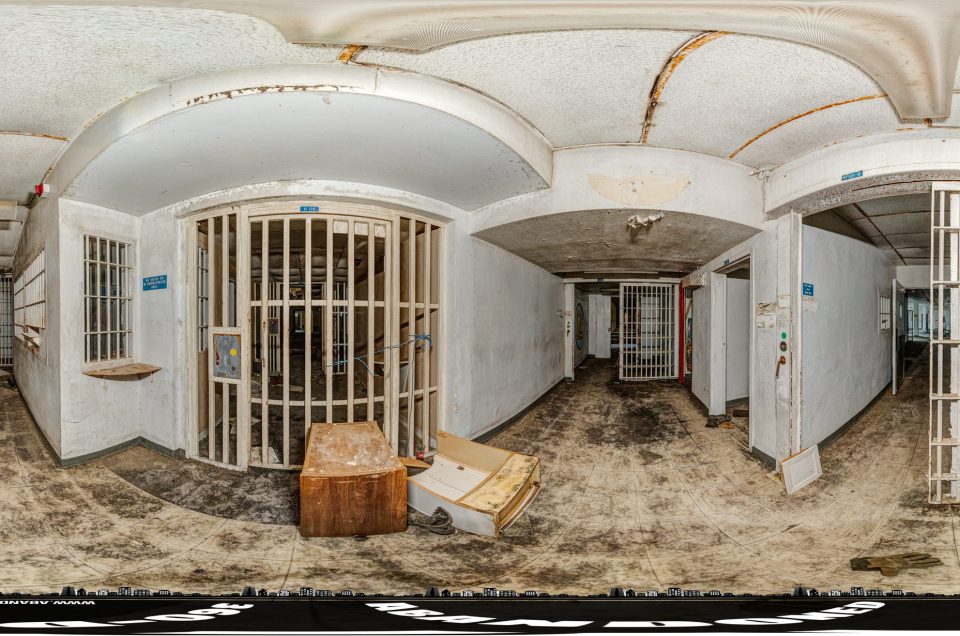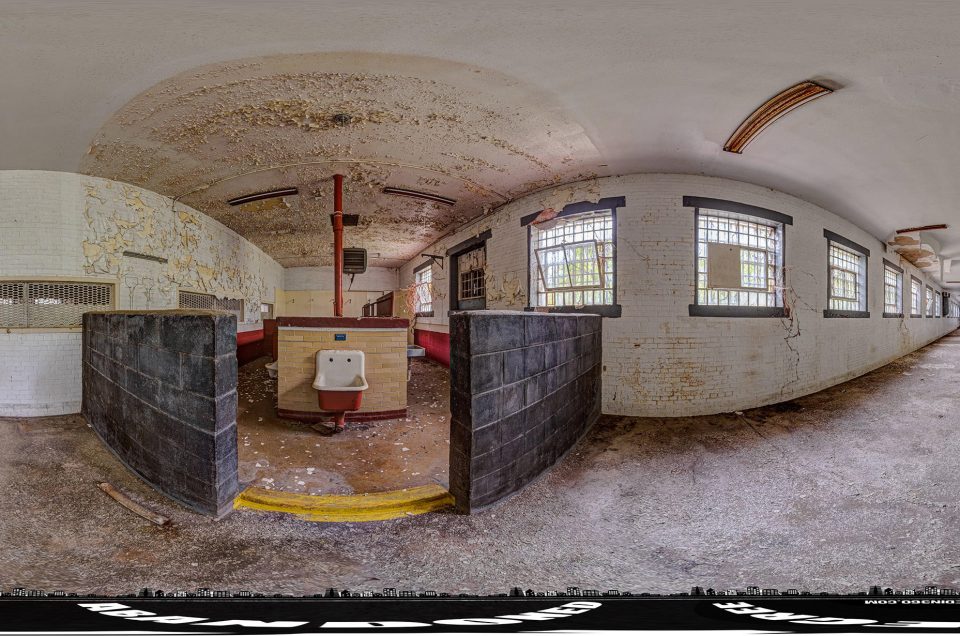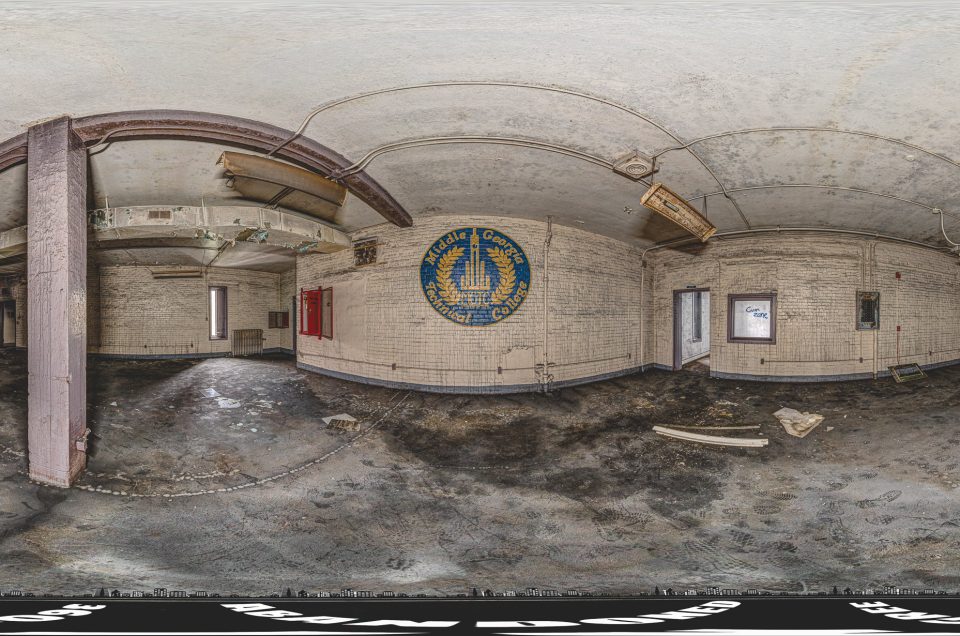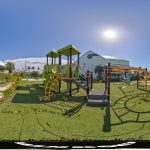Exploring the Abandoned Dunnellon Ranger Station – Florida’s Forgotten Fire Tower
Step into the virtual exploration of the Dunnellon Ranger Station through an immersive 360-degree panoramic tour captured by the Abandoned in 360 Urbex Team. This unique experience brings the station’s weathered architecture and atmospheric surroundings directly to your screen, allowing you to appreciate the details that make it a fascinating subject for urban explorers.
With eight panoramic images to explore, each frame offers a different perspective on this abandoned site’s charm and history. Take your time to navigate through each scene, letting the textures, shadows, and forgotten corners tell their silent story of Florida’s past.
Click here to view it in fullscreen.
A Forgotten Outpost in the Florida Wilds
Nestled off a quiet stretch of SW Highway 484 in Dunnellon, Florida stands a long-abandoned ranger station, a relic of Florida’s mid-century wildfire defense network. This Ranger Station, opened in the early 1950s, once buzzed with activity as lookouts scanned the horizon for smoke. Today it sits silent and overgrown – an abandoned in Florida landmark that beckons those interested in urban exploring in Florida. With its towering steel lookout and weathered office building, the site exudes a mysterious and adventurous aura, as if holding tight to secrets from another era. For urban explorers and history buffs alike, the Dunnellon Ranger Station offers a thrilling journey back in time, into the heart of Florida’s forest history and the golden age of fire lookout towers.
Origins of the Dunnellon Ranger Station
The Dunnellon Forestry Station (as it was officially known) was established in 1953 during Florida’s push to expand wildfire detection infrastructure. It was part of a statewide network of ranger stations and lookout towers that sprang up between the 1930s and 1950s, when Florida’s timberlands and rural communities were highly vulnerable to wildfires. About 200 steel fire towers were built across the state in that period, and Dunnellon’s was among the later additions – a testament to Florida’s growing commitment to forest protection in the post-World War II era.
At the Dunnellon station, the Florida Forest Service (then known as the Florida Forest and Park Service) erected a tall metal fire lookout tower and a modest one-story ranger office. The steel tower, likely around 100 feet tall, was anchored into the sandy soil and topped with a small 7-by-7-foot observation cab. Rangers could climb its steep steps to gain a panoramic view over the pine flatwoods and scrublands of southwest Marion County. From this lofty perch, they watched for the thin wisp of smoke that could be the first sign of a wildfire. The adjacent ranger station building – roughly 1,000 square feet of office and storage space – served as a base of operations. It housed maps, radios, and firefighting tools, and it was likely a hub where local forest rangers coordinated fire crews and maintained equipment like the swamp buggies and plow trucks used to battle brush fires.
Historical Context: When the Dunnellon Ranger Station opened, Florida was entering a new era of wildfire management. Decades earlier, in the 1930s, fire lookout towers had been introduced (often built by the Civilian Conservation Corps) to combat rampant wildfires. By the 1950s, steel towers had replaced nearly all older wooden watchtowers statewide. The Dunnellon tower was part of this modern wave – built on the ground and then hoisted upright by crane, as was common practice. Its completion in 1953 filled a critical gap in coverage; the station’s location along Highway 484 positioned it to monitor the vast tracts of the Florida Highlands area and the outskirts of the Withlacoochee State Forest. This region, dotted with rural homesteads and dry scrub vegetation, was prone to wildfires, especially during Florida’s winter dry season. Having a manned lookout here meant early warnings for fires that might threaten the communities of Dunnellon, Romeo, and beyond.
Heyday of the Ranger Station: Life on the Fire Tower
Throughout the 1950s to 1970s, the Dunnellon Ranger Station was a vital outpost of Florida’s Division of Forestry. A ranger or fire tower operator would climb the tower’s zigzag of stairs each morning, armed with binoculars and a firefinder (a rotating map device used to pinpoint fire locations). From the cab high above the treetops, they kept a 360-degree vigil over the green expanse. On a clear day, the lookout could likely spot smoke plumes many miles away – perhaps as far as the Gulf hammock to the west or deep into the Ocala National Forest to the east. When a wisp of smoke was sighted, the ranger used the alidade and map to get a compass bearing and approximate distance. They would then radio down to the station office (or directly to a central dispatch) to report the fire’s location. Often, multiple towers would triangulate the fire – by comparing bearings from Dunnellon and another nearby tower, rangers could pinpoint the blaze on a map. Ground crews or brush trucks would then be deployed to contain the flames.
Aside from fire watching, the station staff performed various forestry duties. The on-site rangers likely maintained firefighting equipment, performed controlled burns (a preventive measure to reduce underbrush fuel), and educated locals on fire safety. The small Dunnellon office might have hosted occasional training sessions or served as a meeting point for volunteer fire fighters in the days before modern fire stations. Community members driving down Highway 484 would recognize the tall silver-colored tower as a local landmark – a reassuring presence symbolizing vigilance against wildfires. Indeed, over the decades, numerous wildfires were spotted from this very tower in time for firefighters to respond. Marion County, where Dunnellon is located, experienced many significant fires over the years, from muck fires in the 1960s to the infamous statewide fire outbreak of 1998. It’s quite possible that during the dry spring of 1998, when Florida battled a historic firestorm, a lone lookout in the Dunnellon tower scanned the smoky horizon, ready to sound the alarm.
Life at the ranger station was undoubtedly rustic and challenging. Especially in earlier years, the tower had no elevator – only an open-grate stairway climbing into the sky. Tower men and women braved summer heat, lightning storms, and dizzying heights as part of the job. The station’s office building would have been basic, perhaps cooled by a single fan or an early air conditioner rumbling against the humidity. A wall-mounted pencil sharpener still clings to a wooden window sill inside – an artifact of those analog days when everything, including wildfire maps and logs, was done by hand. One can imagine a ranger standing by that very window decades ago, sharpening pencils and marking down coordinates of a distant smoke column while keeping one eye on the woods outside. These small details offer a poignant glimpse into the daily routine at the station during its heyday.
Why Was the Station Abandoned?
If this ranger station was so important, one might wonder why it was eventually abandoned. The answer lies in the march of technology and changes in wildfire management strategy. By the late 20th century, Florida’s approach to fire detection was evolving. New tools – from aerial surveillance to satellite hot-spot monitoring – began to supplement and outperform the old tower system. Airplanes could sweep over vast areas and spot fires more quickly, and advanced communications allowed faster reporting by residents and fire crews. Additionally, Florida’s population growth meant that previously remote areas (like portions of Marion County) became more developed; more eyes were on the ground to report fires via 911, reducing reliance on lonely sentinels in the sky.
By the 1990s, the Florida Division of Forestry (now Florida Forest Service) started decommissioning many of its fire lookout towers statewide. At one time Florida had roughly 300 lookout towers; by the year 2000 only a few dozen were still routinely staffed, and plans were underway to shutter most of the rest. In a 1999 report, officials noted that of the original towers, only 44 were in daily operation, with even those slated to drop to about 30 in the near future. The Dunnellon Ranger Station was likely among the sites phased out in this period.
Two major factors drove the closure: efficacy and cost. First, modern technology and development made the towers largely obsolete. Wildfires that once would have raged unnoticed for precious early minutes were now quickly spotted by residents with cell phones or by fire patrol aircraft. The tower system that had dutifully served Florida for most of the 20th century simply wasn’t as critical anymore in the 21st. Second, maintaining these aging structures and staffing them was costly. Each tower required a trained observer and regular upkeep (protecting the metal from rust in Florida’s climate, ensuring steps and landings were safe, etc.). For an agency facing budget constraints and able to leverage airplanes and modern gear, it made financial sense to consolidate operations.
In the case of Dunnellon, the Florida Forest Service likely shifted resources to its main district office in Ocala and to mobile patrol units. The Marion County Forester’s office at Silver Springs Boulevard in Ocala became the hub for local wildfire response, rendering the small Dunnellon outpost redundant. By the mid-2000s, the Dunnellon Ranger Station had quietly fallen out of active use. An explorer who ventured into the abandoned office years later discovered a map on the wall dated “Spring/Summer 2008,” suggesting that around 2008 was the last time the station’s information was updated. This hints that the site was likely decommissioned sometime shortly after 2008 – meaning it operated for over half a century before being left to the elements. Some longtime residents recall when the tower was still manned in the early 2000s, but by 2010 it was definitely closed, with the gate locked and no ranger truck in the driveway.
A Ghost on the Landscape: Present-Day Decay
Today, the Dunnellon Ranger Station stands as a ghostly landmark amid encroaching woods and quiet rural homesteads. The property, still owned by the state, has been left largely untouched since its closure. Nature is slowly reclaiming it – tall grasses and weeds blanket the once-trimmed lawn, and young oak and pine saplings have sprouted around the grounds. The fire tower itself still rises defiantly into the sky, its steel frame weathered to a dull grey. From a distance it looks intact, but up close one can see rust nibbling at the bolts and legs. A padlock and “No Trespassing” sign typically secure the bottom stairwell, but that hasn’t deterred curious explorers from gazing up in awe or even illicitly climbing a few steps (not recommended – these old towers are dangerous to climb and no longer maintained, as experts warn). The cab at the top likely still holds the remains of an old stool or desk where the watcher once sat. With shattered glass or missing shutters, the little cube at the summit now hosts only hawks and vultures that perch on its railings.
The station’s office building is a small rectangular structure set a short distance from the tower’s base. Built in the early 1950s, it may be constructed of concrete block or wood frame with simple siding. Time and weather have left their mark: the windows are now boarded or shattered, and the paint (once a utilitarian forest green or sandy beige) has peeled away to reveal grey wood and patches of mildew. The front door hangs ajar, its padlock long broken by vandals or the elements. Above the door, the outline of old lettering or a placard can be made out – perhaps it once read “Dunnellon Forestry Station” or simply “Florida Forest Service.” Stepping inside (for those bold enough to do so, minding weak floors and possible critters) is like entering a time capsule. Graffiti mars some of the walls, but many original features remain. An outdated calendar or two might still cling to a bulletin board, and file cabinets – now empty and rusting – are pushed against the walls. In one corner, explorers found that faded map from 2008, still tacked up as if someone might return tomorrow to update it. The map depicts local forests, roads, and perhaps colored pushpins marking past fire locations. Dust motes dance in shafts of sunlight that pierce through holes in the roof, illuminating the scene of bygone busy days.
Small artifacts give this abandoned ranger station its haunting character. Besides the aforementioned pencil sharpener on the window sill, there may be other remnants: an old fire helmet or shovel blade left behind, fragments of radio equipment wiring, even coffee cups or log books too water-damaged to read. One could easily imagine the voices that once filled this space – urgent radio chatter during a wildfire flare-up, or the idle conversation of a lone ranger eating lunch at his desk on a quiet afternoon. Now, the only sounds are the buzz of cicadas and the wind whispering through broken window frames.
Urban Exploring in Florida: The Lure of the Ranger Station
For urban explorers in Florida, sites like the Dunnellon Ranger Station are treasured finds. They combine natural beauty, historical significance, and a touch of mystery. The station’s secluded location is down a sparsely populated stretch with few onlookers means an intrepid explorer can feel truly isolated – it’s just you and the echoes of Florida’s past. The experience of visiting is often described as stepping into a Cold War-era postcard. The fire tower looms like a giant metal sentinel, and the dilapidated station building, half-swallowed by palmettos, feels like a forgotten frontier cabin. On overcast days or at dusk, the site’s atmosphere can turn outright eerie – perfect for dramatic photography or simply a spine-tingling adventure story to tell.
However, with the allure of such places comes responsibility. As with any location abandoned in Florida, explorers must be cautious and respectful. The Dunnellon Ranger Station is state property; technically, unauthorized entry is trespassing. While the site isn’t actively monitored, visitors should be aware of the risks. Structural instability is a major concern – floors could give way, and climbing the old tower is extremely dangerous (not to mention officially off-limits). Additionally, Florida’s wildlife might have taken up residence. It’s not uncommon for snakes, spiders, or even the occasional black bear or Florida panther (though rare in this region) to wander through abandoned structures. Explorers should also consider the weather – summer heat and thunderstorms, or the clouds of mosquitoes that come out around the nearby marshy areas. In short, anyone urban exploring here should go prepared and put safety first.
Those who do venture here (at their own risk) often come away with stunning photos and a newfound appreciation for Florida’s firefighting heritage. The mysterious and adventurous tone of the site ignites the imagination. Some have described gazing up at the tower silhouetted against a sunset and feeling a connection to the past – as if the ghosts of old rangers are still up there, scanning the horizon. The station stands as a monument to a different time: when communication was analog, when humans rather than cameras watched over the land, and when Florida’s now-booming counties were rural, sleepy places.
The Legacy and Historical Significance
Beyond its appeal to adventurers, the abandoned Dunnellon Ranger Station holds genuine historical significance. It represents the legacy of Florida’s wildfire management program and the evolution of conservation practices in the state. When it was built in 1953, Florida was largely rural outside of a few big cities. Wildfires were a real and present danger to livelihoods, and the establishment of stations like Dunnellon’s was a turning point that brought organized fire control to even the smaller communities. This contributed greatly to the safer development of areas like Marion and Citrus Counties over the following decades.
Moreover, the station is a physical reminder of community resilience. Many local elders may still remember times when, thanks to the quick eyes in the Dunnellon fire tower, their family farms or neighborhoods were saved from a wildfire. Even as recently as 2021, an 80-acre wildfire in the Florida Highlands area near Dunnellon led to the evacuation of 25 homes. While that fire was managed with modern methods, it underscores how critical fire detection is in this region – the same role the Dunnellon tower served for so long. Each wildfire successfully spotted and quelled in the past helped protect the burgeoning settlements around Dunnellon and Ocala. In that sense, this humble ranger station contributed to the growth and safety of Marion County.
The historical fabric of the site also ties into broader themes. It’s part of Florida’s mid-century narrative of balancing human expansion with natural stewardship. Along with the creation of state parks and the efforts to drain or preserve swamps, the fire towers were a piece of the strategy to make Florida’s wild lands more habitable and safe. Now that most of these towers have been decommissioned, preservationists have noted their cultural value. Statewide, roughly 100 fire towers still stand (out of the originals), but many are slowly disappearing due to decay or deliberate removal. The Florida Forest Service has in some cases auctioned off old towers to private individuals (often ham radio enthusiasts or museums) who carefully dismantle and re-erect them elsewhere to give them new life. About 50 towers have been saved this way. Dunnellon’s tower, however, remains in situ – not yet rescued by any preservation effort, but also not torn down. This makes it an increasingly rare specimen of Old Florida infrastructure, a piece of living history rusting quietly under the sun.
Conclusion: Echoes in the Pines
Visiting the abandoned Dunnellon Ranger Station is like opening a window to Florida’s past. The mystery and adventure that permeate this site are tangible – from the silent ladder rungs of the fire tower that once carried vigilant watchmen, to the dusty map in the office marking the spring of 2008, frozen in time. For those passionate about urban exploring in Florida, few places offer such a blend of natural beauty, historical significance, and eerie charm. It’s a spot where you can almost hear the echoes of a lost era: the crackle of a radio, the distant thunder of a summer storm, and the firm voice of a ranger saying “Fire spotted, 5 miles to the southwest.”
While the Dunnellon Ranger Station now lies deserted, its story continues to resonate. It tells of Florida’s eternal tussle with nature – how we once built lonely towers to keep watch over an untamable landscape, and how those towers became obsolete as we found new ways to live with the land. It reminds us that even in abandonment, there is value: value in remembering the efforts of those who came before, and value in preserving the stories and structures that shaped our communities. As you stand beneath the towering sentinel at dusk, with the sky turning orange and the silhouettes of pines stretching across the horizon, you feel a connection to that legacy. The abandoned ranger station may be crumbling, but it stands proud as a monument to Florida’s wilderness and the guardians who once protected it. For an urban explorer, it’s a thrilling adventure; for a history enthusiast, it’s a poignant lesson; and for everyone else, it’s a reminder that even in the overgrown corners of our world, history never truly dies – it simply waits quietly for someone to listen.
If you liked this blog post, you might be interested in learning about the abandoned White Duck Taco Shop in North Carolina, the Annie Lytle Elementary School in North Florida, or the Regency Mall in Georgia.
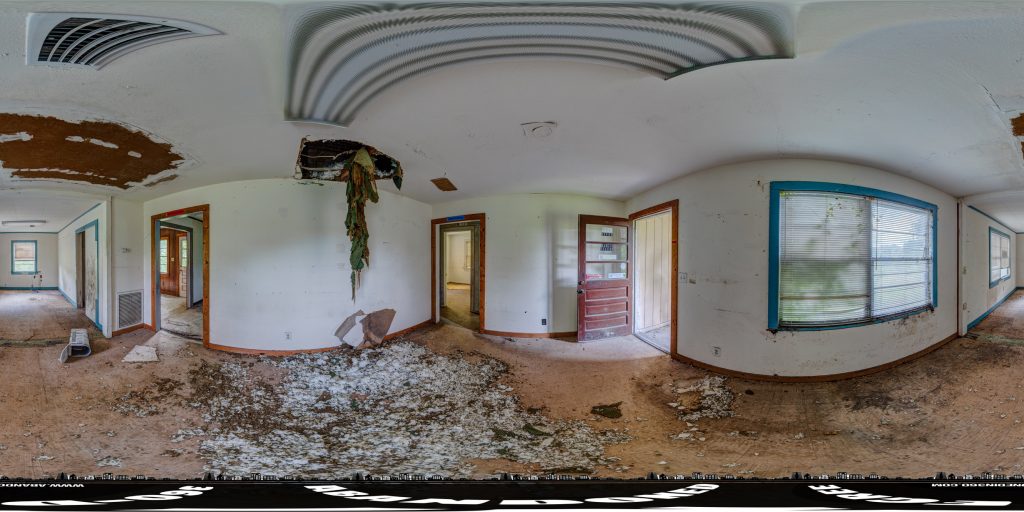
A 360-degree panoramic image captured inside the abandoned Dunnellon Ranger Station in Central Florida. Photograph by the Abandoned in 360 Urbex Team
Welcome to a world of exploration and intrigue at Abandoned in 360, where adventure awaits with our exclusive membership options. Dive into the mysteries of forgotten places with our Gold Membership, offering access to GPS coordinates to thousands of abandoned locations worldwide. For those seeking a deeper immersion, our Platinum Membership goes beyond the map, providing members with exclusive photos and captivating 3D virtual walkthroughs of these remarkable sites. Discover hidden histories and untold stories as we continually expand our map with new locations each month. Embark on your journey today and uncover the secrets of the past like never before. Join us and start exploring with Abandoned in 360.
Equipment used to capture the 360-degree panoramic images:
- Canon DSLR camera
- Canon 8-15mm fisheye
- Manfrotto tripod
- Custom rotating tripod head
Do you have 360-degree panoramic images captured in an abandoned location? Send your images to Abandonedin360@gmail.com. If you choose to go out and do some urban exploring in your town, here are some safety tips before you head out on your Urbex adventure. If you want to start shooting 360-degree panoramic images, you might want to look onto one-click 360-degree action cameras.
Click on a state below and explore the top abandoned places for urban exploring in that state.
